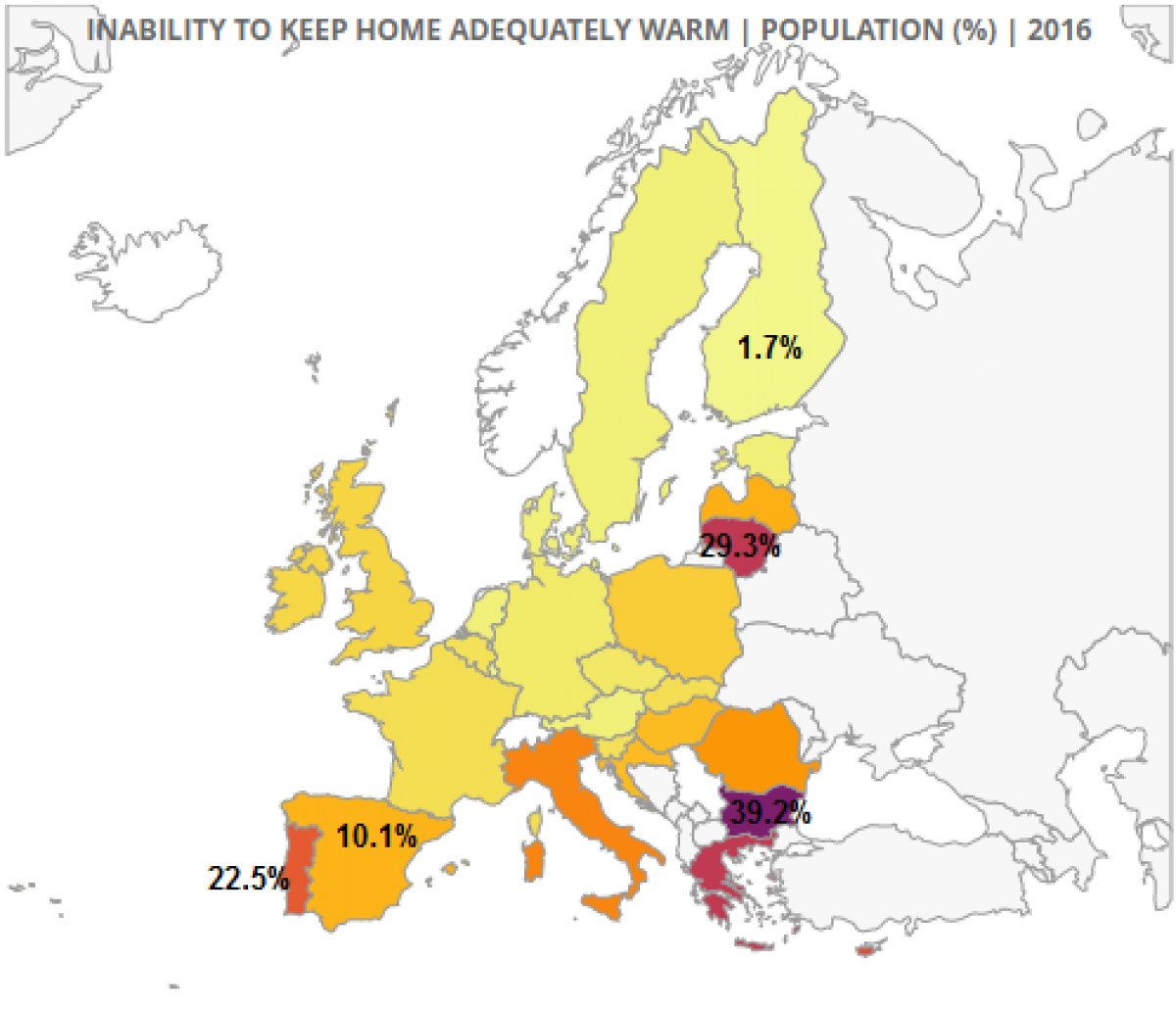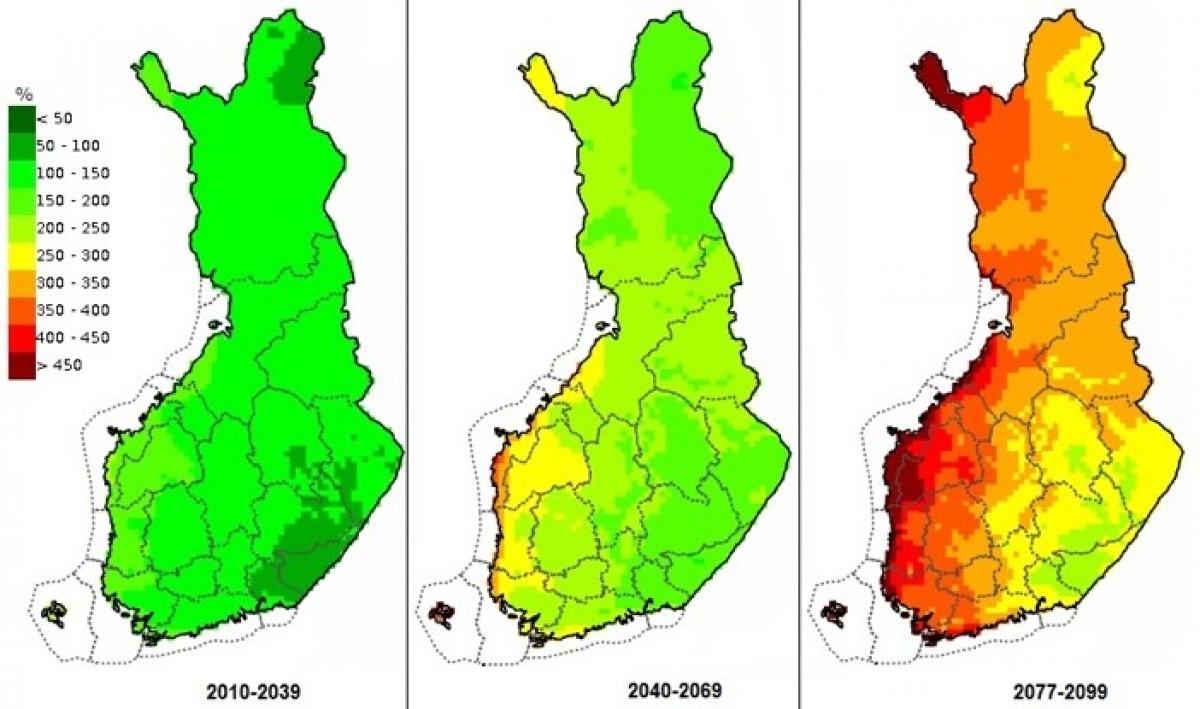Castaño-Rosa, R. (2021). Energy poverty in Finland. EP-pedia, ENGAGER COST Action.
Perspective on energy poverty in the policy debate of Finland
Energy poverty (EP) has been hardly studied in Finland, mainly due to a lack of research data, leading it to be partly hidden as a phenomenon. Thus, EP is not formally mentioned in the public debate in Finland, nor is there any definition of or approach to EP within policymaking. This is also mainly because current indicators used to analyse EP are inadequate for application in the Finnish context; Figure 1 shows that, according the selected indicator ("Inability to keep home adequately warm"), in 2016, only 1.7% of population are in EP in Finland, in contrast to Bulgaria (39.2%), Lithuania (29.3%), Portugal (22.5%) and Spain (10.1%). However, over 75.9% of households were unable to keep their home comfortably cool in Finland in 2012 (secondary indicator according to the EPOV) (European Commission, 2018), mainly due to existing housing stock characteristics (Castaño-Rosa, R. Pelsmakers & Sukanen, 2020). So, though few Finnish households report have trouble keeping adequately warm, three quarters say they cannot keep their homes cool enough, showing that EP is a multiple-factor issue that cannot be assessed by using current indicators across all European countries (i.e. primary indicators according to the EPOV) (European Commission, 2018). Rather it requires special attention depending on the studied country.

In 2013, the Ministry of Environment examined the importance of EP in Finland, concluding that only a small proportion of households are energy poor in Finland (Oja et al., 2013). This is why Finland does not have national objectives or strategies with regards to EP, meaning that prevention and mitigation of EP is subsumed in general social policy.
In a first attempt to evaluate EP in the Finnish context, several European researches highlighted that the main factors which cause EP, and which need further research, are heating, ventilation and cooling issues (Boemi & Papadopoulos, 2019); high energy prices (International Energy Agency (IEA), 2018); living in large energy inefficient dwellings (Ortiz et al., 2019); living outside urban areas (Openex network, 2019); households where individuals have multiple disabilities (Aristondo & Onaindia, 2018); and low-income households (Meyer et al., 2018). In Finland, the symptoms of EP are mainly dealt with through various financial support mechanisms, such as social loans, sickness insurance, transfers for the poorest households, etc. Such mechanisms do not tackle the actual causes of EP nor its future impacts (e.g. increase of energy prices and cooling energy demand, impacts on health and well-being, etc.) (Castaño-Rosa, R. Pelsmakers & Sukanen, 2020).
Research perspective on energy poverty in Finland
Energy poverty (EP), the inability of an individual to secure a materially and socially needed level of energy service in the home (Bouzarovski & Petrova, 2015), has traditionally been assumed to be a problem of countries with severe winters and low-income households living in poor quality buildings. But the health and wellbeing impacts of increasing summer temperatures due to climate change has led to summertime EP being considered (Castaño-Rosa et al., 2020).
While a changing climate is likely to reduce EP vulnerability in winter, there is increasing concern that it will increase vulnerability in summer due to hotter summer periods: recent summer heatwaves experienced in Europe consistently exceeded previous summer temperature records. In the Nordic region, buildings have traditionally been designed for cold winters, and the Nordic region is therefore expected to be particularly affected by warmer summers; for example, in summer 2012, 75.9% to 92.8% of households were unable to keep comfortably cool in Finland and Sweden, respectively (secondary indicator of energy poverty according to the EPOV) (European Commission, 2018). But this indicator is no longer collected, leaving it more difficult to recognize or monitor summer energy poverty, despite the fact these cooling problems are expected to increase due to climate change.
Figure 2 shows the projected impact of climate change on future cooling energy demand increases across Finland: the Southwest areas of Finland will be the most affected (increase of 300% to 400% of 2010 values by 2100), representing those areas that are most vulnerable to climate change and, as expected, likely increased summer energy poverty if housing and cooling system quality remains the same. As such, policymakers should pay special attention when designing new cities and building policies and regulations, given that current building stock characteristics and urban composition are likely to increase the exposure of people to certain vulnerabilities, such as building overheating.

The issue of increased summertime overheating (by means of excess indoor temperatures), and EP vulnerability is not just a matter of increased energy consumption or CO2 emissions, but a public health issue. For example, the most vulnerable people spend most of their time at home, living with high indoor temperatures in the summer (caused by building overheating) and poor indoor air quality (due to inadequate ventilation systems), leading to different physical and mental health issues, such as heat stroke, fatigue, decreased ability to concentrate and social exclusion – e.g. people feel ashamed to invite others at their home. In the worst case-scenario mortality rates are increased, particularly for the elderly, children disabled people or pregnant women (Pilli-Sihvola et al., 2018).
EP is a multidimensional issue in all European countries and the root of this issue differs from country to country, so that each country should develop new strategies and policies to address EP. In Finland, there is no definition and/or plan to understand EP vulnerability because it has not been recognized as a problem in winter, according to current EP indicators. However, summer EP is identified as a significant issue now, and in a future changing climate (Castaño-Rosa, R. Pelsmakers & Sukanen, 2020). Hence, this work argues for a new more holistic and Finland-specific approach to better understand EP vulnerability in the Finnish context, especially because of the hooter summer temperatures expected due to climate change.
Aristondo, O., & Onaindia, E. (2018). Inequality of energy poverty between groups in Spain. Energy, 153, 431–442. https://doi.org/https://doi.org/10.1016/j.energy.2018.04.029
Boemi, S.-N., & Papadopoulos, A. M. (2019). Energy poverty and energy efficiency improvements: A longitudinal approach of the Hellenic households. Energy and Buildings, 197, 242–250. https://doi.org/https://doi.org/10.1016/j.enbuild.2019.05.027
Bouzarovski, S., & Petrova, S. (2015). A global perspective on domestic energy deprivation: Overcoming the energy poverty-fuel poverty binary. Energy Research and Social Science, 10(10), 31-40. https://doi.org/10.1016/j.erss.2015.06.007
Castaño-Rosa, R. Pelsmakers, S., & Sukanen, H. (2020). Rethinking the building environment: climate change mitigation and adaptation in a Nordic climate. Beyond 2020. World Sustainable Built Environment Conference, 6.
Castaño-Rosa, R., Solís-Guzmán, J., & Marrero, M. (2020). Energy poverty goes south? Understanding the costs of energy poverty with the index of vulnerable homes in Spain. Energy Research & Social Science, 60, 101325. https://doi.org/https://doi.org/10.1016/j.erss.2019.101325
European Commission. (2018). EU Energy Poverty Observatory (CN ENER/B3/SER/2015-507/SI2.742529). https://www.energypoverty.eu/
Finnish Meteorological Institute. (n.d.). Climate guide.fi. Climate and Impacts. Retrieved November 24, 2019, from https://ilmasto-opas.fi/en/datat/vaikutukset#SykeDataPlace:vaikutukset
International Energy Agency (IEA). (2018). Energy Policies of IEA Countries: Finland 2018 Review. https://webstore.iea.org/energy-policies-of-iea-countries-finland-2018-review
Meyer, S., Laurence, H., Bart, D., Lucie, M., & Kevin, M. (2018). Capturing the multifaceted nature of energy poverty: Lessons from Belgium. Energy Research & Social Science, 40, 273–283. https://doi.org/https://doi.org/10.1016/j.erss.2018.01.017
Oja, L., Vaahtera, A., Vehviläinen, L., Ahvenharju, S., & Hakala, L. (2013). Household energy costs: Energy poverty report. https://doi.org/978-952-11-4205-5
Openex network. (2019). European Energy Poverty Index (EEPI). http://www.buildup.eu/en/practices/publications/european-energy-poverty-index-eep-i
Ortiz, J., Casquero-Modrego, N., & Salom, J. (2019). Health and related economic effects of residential energy retrofitting in Spain. Energy Policy, 130, 375–388. https://doi.org/https://doi.org/10.1016/j.enpol.2019.04.013
Pilli-Sihvola, K., Harjanne, A., & Haavisto, R. (2018). Adaptation by the least vulnerable: Managing climate and disaster risks in Finland. International Journal of Disaster Risk Reduction, 31, 1266–1275. https://doi.org/https://doi.org/10.1016/j.ijdrr.2017.12.004
